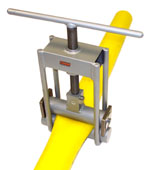What techniques are available for isolating sections of PE pipe for maintenance?
The design of PE pipe networks should follow conventional network practices with the installation of valves at convenient or critical locations. The valves can then be operated to isolate sections of the pipe network for maintenance. Additionally however PE pipe networks have the advantage that more localised isolation can be implemented by the use of pipe ‘squeeze-off'. Squeeze-off is used in routine and emergency situations to stop or nearly stop flow in PE pipe by flattening the pipe between parallel bars.
Squeeze-off (Fusion) courtesy of Fusion plc PE pipe squeeze-off utilises the ductility of PE by allowing the pipe to be squeezed together using relatively simple but specially designed squeeze-off tools thus preventing the flow of fluid and isolating the pipe section. It is important that only specifically designed tools are used and that the squeeze-off controls are set for the specific diameter and SDR of the pipe in order to control the degree of compression of the PE pipe and prevent any damage.

The squeeze off tools are generally mechanically operated up to about 125mm diameter and hydraulically operated for larger diameters. However squeeze-off equipment is not readily available for the largest diameters of PE pipe. It is important to follow the manufacturers instructions when using these tools and to use tools appropriate for the pipe diameter and SDR. Also the tools need to be capable of resisting the operating pressure of the pipe, and there are limits to the pressures that they can sustain.
Properly implemented squeeze-off, using the correct tools, is not expected to cause damage to the PE pipe, which regains its circular cross-section after the tool is released. However squeeze-off is not recommended to be done more than once at any location. If repeated flow control is required a valve or an appropriate flow control device should be installed in the system.
Squeeze-off is not intended as a means to throttle or partially restrict flow.
Complete flow stoppage may not occur in all cases. When squeezing larger pipes, particularly at higher pressures, some seepage is likely. When seepage is not acceptable, it may be necessary to vent the pipe in-between two squeeze-offs. Any work performed must be downstream of the second squeeze-off.
Inflatable bag flow stopping equipment can also be used for PE pipes. A saddle fitting needs to be fixed to the pipe, through which the inflatable bags are inserted. It is important that the correct saddle fitting is used compatible with the equipment being used. Reference should be made to the manufacturers instructions.

